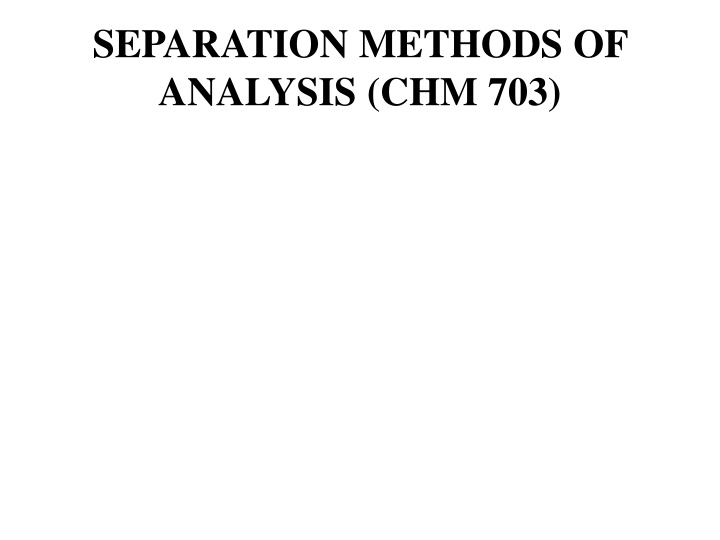
Advanced Separation Methods of Analysis in Chemistry
Explore the various separation techniques essential for analytical chemists, such as solvent extraction, gas chromatography, and liquid chromatography. Learn how differences in physicochemical properties aid in separating components effectively.
Download Presentation

Please find below an Image/Link to download the presentation.
The content on the website is provided AS IS for your information and personal use only. It may not be sold, licensed, or shared on other websites without obtaining consent from the author. If you encounter any issues during the download, it is possible that the publisher has removed the file from their server.
You are allowed to download the files provided on this website for personal or commercial use, subject to the condition that they are used lawfully. All files are the property of their respective owners.
The content on the website is provided AS IS for your information and personal use only. It may not be sold, licensed, or shared on other websites without obtaining consent from the author.
E N D
Presentation Transcript
SEPARATION METHODS OF ANALYSIS (CHM 703)
or compound by simple measurement, no matter what it s concentration or the complexity of the matrix, separation technique would be of no value to the analytical chemist.
differences in physicochemical properties between the various components of mixture volatility; solubility, charge, molecular size, shape, and the polarity are the most useful. In this respect, a change of phase has occurred during distillation or formation of new phase as in precipitation, can provide a simple means of isolating a desired component.
component sample most depend on the selective transfer of materials between two immiscible phases. The most widely used techniques and the phase system associated with them are summarized as follows:
Classification of separation techniques
S/NO Technique Phase system
1. Solvent extraction liquid Liquid -
2. Gas chromatography Gas - liquid
3. Liquid chromatography - liquid Liquid
4. Thin - layer chromatography Liquid - solid
Ion exchange and gel formation chromatographyLiquid - solid 5.
6. Supercritical fluid chromatography and electrophoresis Supercritical fluid - liquid or solid liquid.
to a large extent, attainment of optimal condition has to be approached empirically rather than by the application of a rigid theory in the following section which deals with solvent extraction, chromatography and electrophoresis. The minimum theory necessary for an understanding of the basic principle is presented.
transfer of ug to g in quantity between 2 immiscible phases (liquid). Separation is based on solubility differences and selectivity is achieved by pH control and complexation.
extraction and special glass apparatus, soxhlet (for cont. extraction). Batch methods are rapid, simple and versatile.
It sometimes requires large quantities of organic solvents.
Poor resolution of mixture of organic components.
form complexes with other components e.g. solvents.
Analytically, the total amount of solute present in each case is better described in distribution D , Where D CA = amount of solute =
50cm3of ether twice at room temperature.
The rate of movement of a solute is determined by its distribution ratio, D as:
Trapping the eluted component for further analysis by other analytical techniques such as IR and mass spectrometry.
isosceles triangle () formed in the chromatogram can be calculated by multiplying the height by the width at half height, i.e. A= b x h/2.
method is fairly precise and very useful for unsymmetrical peak but subject to errors arising from variation in thickness and moisture content of paper.
